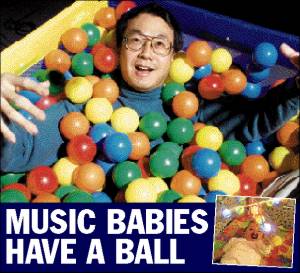| December 6 1998 | INNOVATION |
|
Toys A playpen that pipes out music to match a child's movements could speed up its development and help it to learn faster. Mark Prigg reports |
|
|
|
|
|
MUSICAL BALLS could soon help children to compose their own music.
A team of researchers at the Massachusetts Institute of Technology (MIT) has created a playpen full of coloured balls in which a child can move about to create music. According to Seum-Lim Gan (pictured above), who developed the musical playpen while studying at MIT earlier this year, it could help children develop faster. "The aim of this is to get children to associate music and movement. This helps their development and, ultimately, will get them learning faster by making them more aware of their surroundings," he says. Designed for children over two, the playpen is filled with 400 balls. In each corner is a chain of three balls, with sensors that detect movement. "We had a system with several more sensors, but found we needed only four," says Gan. "Whenever a ball in the pen is moved, the knock-on effect throughout all the balls means a sensor is triggered by even the smallest movements." As a child moves around inside the pen, information is sent to a controlling computer about how fast he is moving and in which parts of the pen. The computer can turn these data into sounds and play music according to how quickly the child is moving and where in the playpen he is. "The music created by the playpen is entirely programmable by the user, but the standard music we include generally becomes faster if the children are moving a lot, but slow and relaxing if they are just moving their arms slowly and want to relax. That allows users to realise very quickly that they can control the music, and they seem to love it - all the demonstrations we have done so far have ended with us having to drag kids out of the pen," says Gan. Although the project is on hold while Gan works as a toy inventor, he hopes a commercial version of the playpen will soon appear. "The playpen is still there at MIT and works very well. I hope it's just a matter of time before someone picks it up and produces a commercial version. The MIT system, which relies on a PC to process the data, would cost $2,000-$3,000 (£1,200-£1,800) but a commercial version with the electronics integrated into a side of the pen would be cheaper. Gan also hopes to attract serious musicians to the playpen. "When you are inside the pen it is almost like swimming through water, and it would be a very creative way to make music," he says. The outputs from the playpen can be sent to any synthesiser or music-generating software, and the system uses a standard known as Midi to communicate with almost any electronic musical instrument. "It would certainly look impressive on stage to have musicians rolling about in giant playpens," says Gan. A prototype of the system allowed users to create music by moving their hand around a bowl of sweets. The movement was picked up by eight sensors on the edge of the bowl and the music was altered accordingly. MIT has also developed a more advanced system for babies, designed to allow them to communicate with friends through a mobile above their cot (pictured above, right). It was developed by Gan and Gili Weinberg. The BabySense system uses a mobile containing several brightly coloured lights and a pressure-sensitive mat in the baby's cot. The mat checks whether the baby is in its cot, and whether it is moving, and if so how quickly. The sensors are precise enough to know which arm the baby is moving, or if it is trying to sit up. Once data about the baby's movements have been analysed, the information is used to create light and sound patterns, controlled by the baby, on a mobile above its head. The mobile can also be made to rotate, depending on the baby's movements. A tiny video camera and television screen inside a teddy bear is used for videoconferencing, allowing the baby to see friends or relatives. This can also be used to monitor the baby from a downstairs room, or even another house. "The videoconferencing allows the baby to have a relationship with someone it wouldn't normally see very often, like a grandparent in another country," says Weinberg. "For monitoring the baby, we are developing a screen that looks exactly like a picture frame that people can have on their mantelpieces, allowing them to see what the baby is doing at all times." The BabySense system also allows babies to play with their friends on the Internet. Specially designed toys allow babies to play together. "If a baby nudges the toy, or tries to knock it over, his friend's toy will react in exactly the same way. This allows babies to play games with each other, even on different sides of the world," says Weinberg.
Next page: Medical - Smart needle homes in on veins to make injections painless
|
|
Next page: Medical - Smart needle homes in on veins to make injections painless
|



